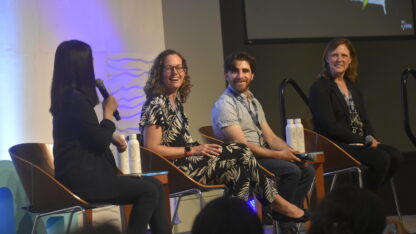Atlanta BeltLine Rethinks How It Tracks Its Progress On Affordable Housing

At the BeltLine’s second quarterly update of 2018, city leaders, including the mayor, sat down for a conversation about equity in Atlanta. From left: Odetta MacLeish-White of the TransFormation Alliance, BeltLine CEO Brian McGowan, Atlanta Mayor Keisha Lance Bottoms, City Planning Commissioner Tim Keane and Atlanta Housing Authority Interim CEO Brandon Riddick-Seals.
Stephannie Stokes / WABE
The Atlanta BeltLine is rethinking how it meets its goals for affordable housing.
One figure has been a big deal when it comes to affordability around the BeltLine: 5,600. That’s the number of low-cost units the trail’s governing body said it would build at the start of the project.
But as the years went on, the Atlanta BeltLine Inc. fell far behind that goal.
Monday night at the organization’s second quarterly update of 2018, CEO Brian McGowan recognized that it strayed too far from the original vision of equity as it worked to build the trail.
Now, as that vision becomes a priority again, he said the BeltLine is aiming for a different number to track its progress of building affordable housing — a bigger number, actually.
“The 5,600 is a goal. That’s not my goal. My goal is 10,000. The whole team is looking at way beyond 5,600. That’s a minimum,” McGowan said.
However, with this new target number, the BeltLine is also changing how it does the math.
Previously, the BeltLine only considered units that its organization or the city’s development arm, Invest Atlanta, created.
Together, the two organizations have created or preserved 1,388 units within a half mile of the BeltLine.
In the trail’s tax allocation district or TAD, a smaller area which doesn’t include single family neighborhoods, that number sits at 901. The BeltLine had aimed the original 5,600 goal at the TAD.
Now, the group wants to count low-cost units that other public agencies, like the Atlanta Housing Authority and the Georgia Department of Community Affairs, are building near the BeltLine, too.
McGowan said since he took over the BeltLine, the agencies have all been working collaboratively. So it makes sense to count their successes together.
If you include these partner agencies, the number of affordable units within a half mile of the BeltLine rises to 2,600. Within the tax allocation district alone, partners have supported 1,600 units.
This story has been updated to include more information about publicly funded affordable units around the Atlanta BeltLine. A previous story also stated that the BeltLine organization will take a new affordable housing goal to the Atlanta City Council. The BeltLine has no plans to do so at this time.








